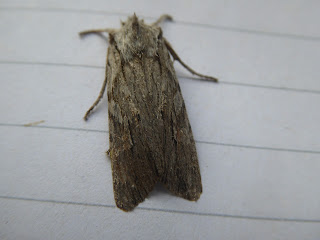Details of garden moths for the last two days of September are given below, with the final day of the month providing quite a reasonable return for the time of year:
(29th) 63 moths of 16 species; nothing new for the garden year-list.
(30th) 151 moths of 26 species, Yellow-line Quaker new for the year-list. A migrant Plutella xylostella came to the MV trap, a species which has been in short supply here this year.
 |
| Red-line Quaker & Yellow-line Quaker, Westcott |
Since 1st October I've been running just the actinic light on its own and, unless a particularly good potential migrant night is forecast, that's the way things will stay until next Spring. The numbers of individual moths have reduced slightly as a consequence, but at this time of year I find that the actinic always brings in a greater variety of species than does the MV trap. The first week of single-trap operations produced the following:
(1st) 59 moths of 16 species; nothing new for the garden list. Of note were a second-brood Swallow-tailed Moth and a dragonfly in the trap, a Southern Hawker Aeshna cyanea.
(2nd) 84 moths of 23 species; Merveille du Jour new for the year-list.
(3rd) 57 moths of 15 species; Brick new for the year-list. Of note was my first October record of Cochylis molliculana (or Neocochylis molliculana as we should now call it).
(4th) 82 moths of 19 species; nothing new for the garden year-list. Of note were a single migrant Udea ferrugalis and the ninth Clifden Nonpareil to appear in the garden this year.
(5th) 53 moths of 17 species; nothing new for the garden year-list.
(6th) 93 moths of 28 species; nothing new for the garden year-list. Of note were a fairly late example of Carcina quercana (although records into October seem to occur quite frequently nowadays) and an exceedingly late Poplar Hawk-moth.
(7th) 88 moths of 24 species; November Moth new for the year-list (octavals checked).
 |
| Swallow-tailed Moth, Westcott 1st October |
 |
| Poplar Hawk-moth, Westcott 6th October |
The pristine Swallow-tailed Moth (1st) was my latest ever and first October record, following one on 28th September last year. Neocochylis molliculana (3rd) is interesting because I had the first for Bucks in Moulsoe Old Wood as recently as 2010 and since then it has increased massively in numbers to become by far the most frequently encountered Cochylis species locally. It was first recorded in the garden during 2017 (11 individuals) and thereafter the annual count rose steadily to 223 in 2020. The rather worn Poplar Hawk-moth (6th) was very unexpected, coming almost a month after my last example (7th September) which at the time was the latest I'd ever seen one.
Lunar Underwing and Beaded Chestnut are currently the highest achievers (15-20 each per night) although neither is appearing in the numbers I've come to expect. The same is true for Black Rustic and the various Sallows, none of which are doing as well as usual here. The garden peak for Lunar Underwing is always either the last week of September or first week of October so theoretically it ought now to be in decline. My highest nightly figure so far has been 88 on 26th September and the total up to 7th October comes to 710, so the 2,000+ counts of the last two years certainly aren't going to be repeated in 2021.
Moths yet to be recorded in the garden this year which I can reasonably expect will do so comprise Acleris sparsana, Pale November Moth, Feathered Thorn, Figure of Eight & Sprawler (all due this month) and then December Moth & Scarce Umber (both due in November). Anything else will be a bonus! Some of the other seasonal moths, of which Winter Moth, Mottled Umber & Chestnut spring to mind, were of course seen way back in January.
Dave Wilton Westcott, Bucks



















































